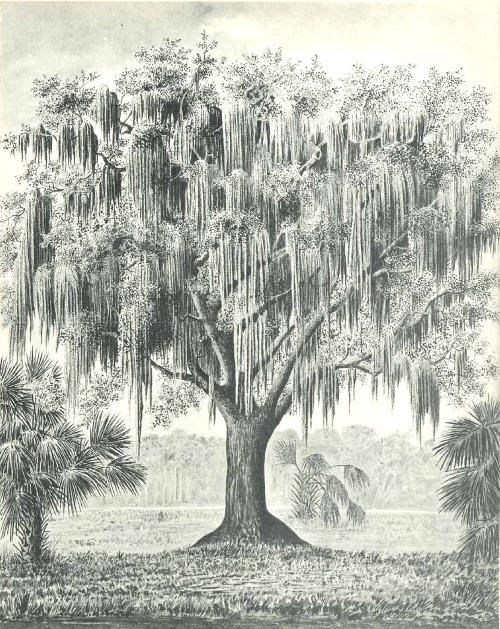Spanish moss
Spanish moss is an air plant or epiphytic flowering plant that mostly grows upon larger trees from South America (with an exception of the Amazon forest) to the South of USA. Epifytics grow on the surface on the branches of trees and derives its moisture and nutrients only from the air. The moss hangs in festoons up to 20 m long. However, the apparent length of the plants is due to numerous shorter individual plants, usually 20 cm long. They form long chains that will break during storms.
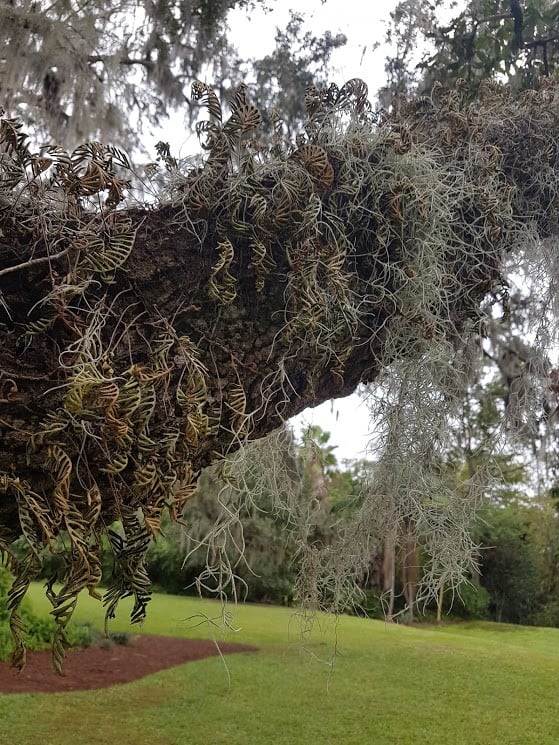
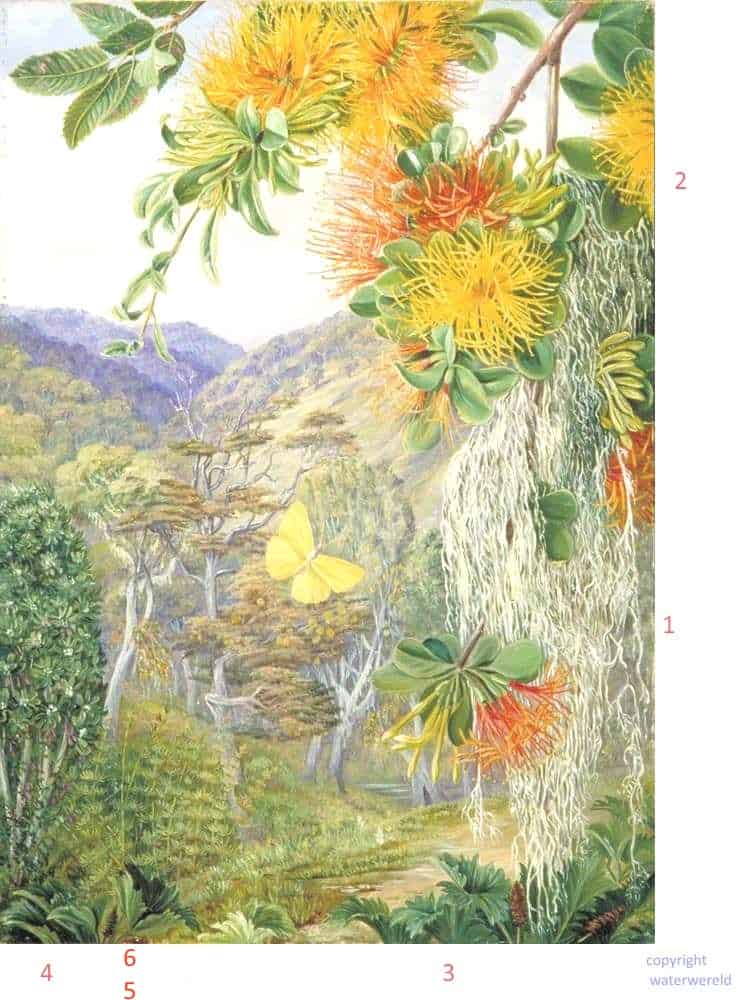
Painting by Marianne North : parasites on beech trees, chili. (1)
1 Spanish moss or Tillandsia usneoides
2 mistletoe of Patagonia or Tristerix corymbosus
3 Chilian rhubarb or Giant Rhubarb or Gunnera scabra or Gunnera tinctoriaDrimys winteri
4 Winter’s bark or Drimys Winteri
5 Colihue Cane or Chusquea culeou
6 Roble beech or Chilean Beech or Lophozonia obliqua or Nothofagus obliqua
Propagation
Spanish moss has two ways of propagation:
Forming seeds : This is done by the very small flowers . These flowers have a yellow core and green leaves. Flowering only happens during the summer. The seeds are tiny and have small wings attached: they are transported by air. They play a role in the spread of the Spanish moss over long distances. Seedlings have root-like holdfasts, which soon dry up as the plant develops; mature plants have no roots.
The vegetativ propagation is most important: fragments of the plant are transported by the wind (typhones) and stick to tree limbs, or are carried by birds as nesting material.
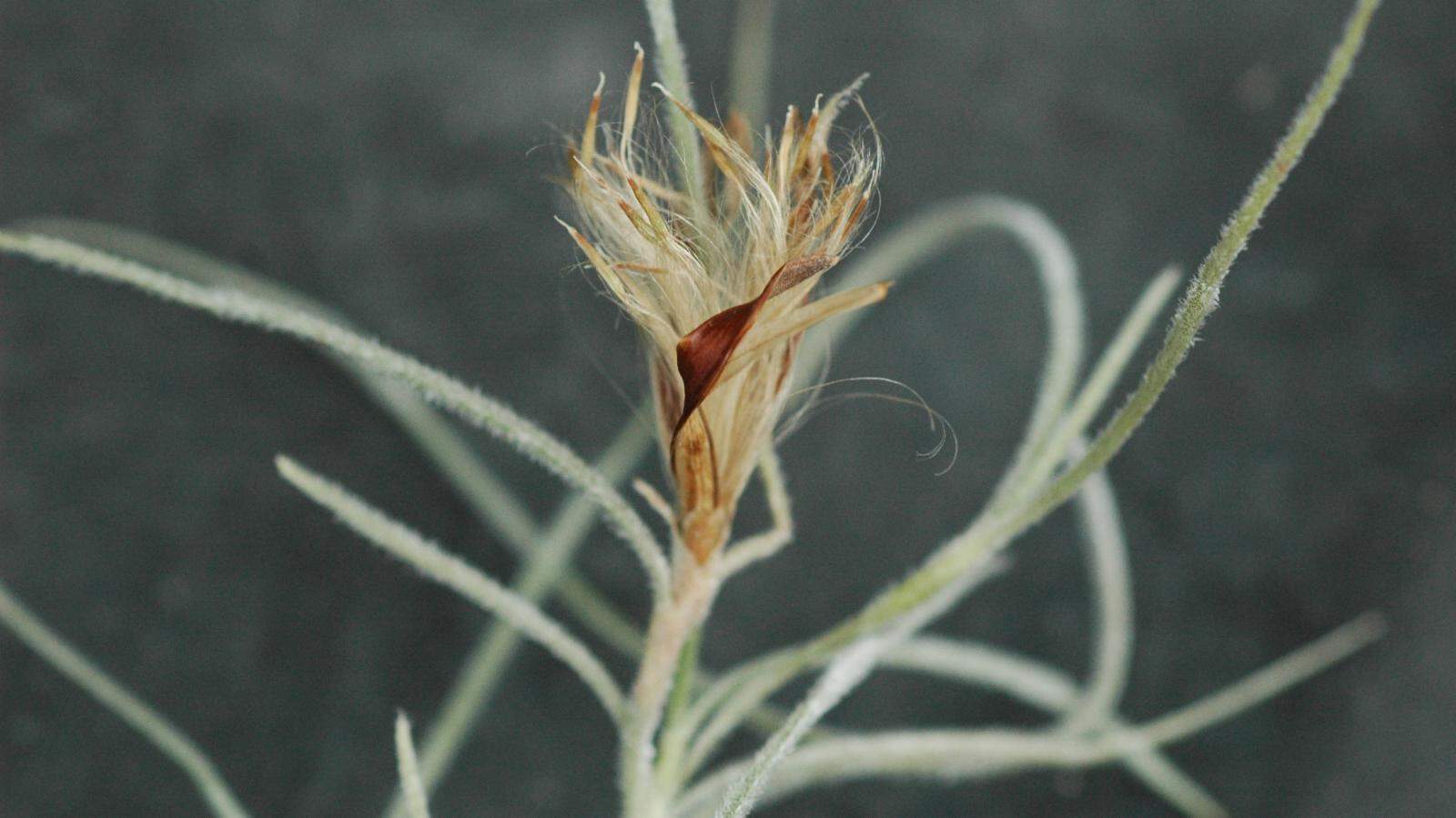 The dark seeds have tiny hairs attached used for air transport . The small scales on the leaves can easely be seen. (4)
The dark seeds have tiny hairs attached used for air transport . The small scales on the leaves can easely be seen. (4)
adapted to drought
Spanish moss is capable to remain two months without any water: The plant remains in a dormant state and the color changes to grey. After two those months the drought becomes dangerous, most spanish mosses dont survive three months.The plant also uses the Crassulacean acid metabolism or CAM: this a way to keep to store CO2 during the night, and uses during the day. The stomata in the leaves can be kept shut during the day to reduce evaporation. Being able to keep stomata closed during the hottest and driest part of the day reduces the loss of water.
Collecting water
The leaves of the Spanish moss are heavely covered with small scales (specialised trichomes). These scales collect rain and dew , but also dust particals. This is the sources for the minerals that are needed. The scales are also the reason that Spanish moss gives a sticky feeling , it helps the plant to attache to branches.
Spanish moss is tolerant.
Spanish moss can grow on the branches of trees but also on electric wires.. It does not appear to favour any hosts. Many tropical trees, however, release chemicals making conditions unfavourable for the growth of Spanish moss. Spanish moss is a slow growing plant, for this reason it prefers dead trees over living trees as they have no competion for light with the leaves of the tree. In Florida the southern live oak and the bald cypress are favorite• trees: they have lots of large, well-spaced almost horizontal branches .
Spanish moss can form curtains with a length over 3 meter.
Spanish moss is of little economic value
Spanish moss has few animals that feed on it as it contains almost no energy. For the same reason it is a bad fodder, it has no nutritive value. Before World War II it was used as a filling material for car seats and as isolation and packing material. Nowadays there is no economical reason to harvest Spanish moss. In South America the plant is sometimes removed from powerlines as is makes them vulnerable to break or produce a short circuit.
Spanish moss can damage trees.
Spanish moss can over-shadowing trees. Also in the case of an huricane can the combination of more weight and catching more wind can weigh down branches. “There is usually no reason to try to eliminate Spanish moss on live oaks, as it rarely will cause any issues. I did, however, find the following information on Spanish moss in a more fragile tree, the pecan. Spanish Moss In southeastern and coastal areas, Spanish moss can occasionally become thick enough in pecan trees to increase ice and wind damage. A small amount of Spanish Moss does little or no damage to trees. Where it is a problem, spray the moss with copper sulfate at the rate of 10 pounds per 100 gallons (6 tbsp per gallon) during the dormant season.”(3)
The bromeliads or Bromeliaceae
Spanish moss is a bromeliad, the smallest member of this large and modern plant family. Bromelias are abundant in forest and mountains of South-Amerca. Most of the bromeliads accumulate water, catched in there rosette of leaves, thus forming small ponds. The invertebra microworld in that water provide the bromelia with nitrogen. (2) Spanish moss doesn’t form rosettes.
The flowers have an deeply hidden ovarium (6) , below the inserting of the flower leaves (3,4): This is only seen in modern plant families.: the inner wall of this ovarium produces nectar, thus attracting polluting insects (this is called septal nectary (7).
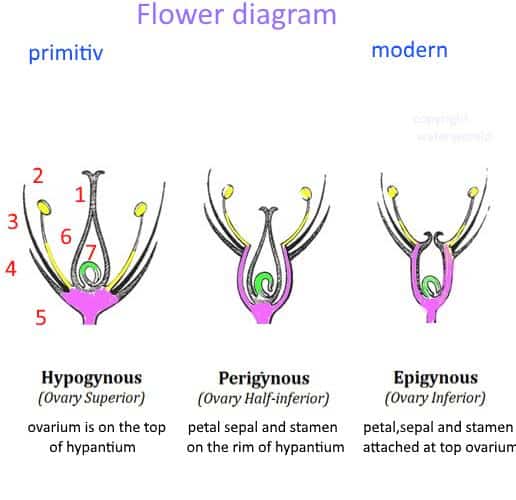
Flower anatomy or Floral diagram showing that the bromeliads are a modern plant family .
1 style , on top : stigma
2 stamen, on top anher
3 petal or corolla
4 sepal or calyx
5 receptacle
6 ovarium
7 ovule. contain septal nectary
source
1 Painting by Marrianne North , 1830-1890, modyfied. The Patagonian mistletoe and Spanish moss are not parasites. For more information have a look at https://www.kew.org/kew-gardens/attractions/marianne-north-gallery
2 Ngai, Jacqueline T.; Srivastava, Diane S. (2006-11-10). “Predators Accelerate Nutrient Cycling in a Bromeliad Ecosystem”. Science. 314 (5801): 963–963. doi:10.1126/science.1132598. ISSN 0036-8075. PMID 17095695.
3 Dr. Kim D. Coder, Professor of Tree Biology & Health Care Warnell School of Forestry & Natural Resources, University of Georgia
4 Foto by http://powo.science.kew.org/taxon/urn:lsid:ipni.org:names:1169665-2

